
A few years back I took a week while warm-water swimming to test a slate of GPS watches in openwater. Like a race, each watch got essentially one go at it, competing against another watch on the other wrist – and then a reference GPS track floating on a swim buoy behind me. That was popular, and with a new slate of GPS devices over the past year or two, I figured it was time to do it again. This time expanding the test group to a dozen GPS watches, over three weeks of openwater swims.
Here was the lineup this year, focusing on the most popular watches for triathletes and openwater swimmers:
– Apple Watch Series 6
– Apple Watch SE
– COROS VERTIX 1
– COROS VERTIX 2
– Garmin Forerunner 945
– Garmin Forerunner 945 LTE
– Garmin Fenix 6 Pro (Solar)
– Garmin Instinct Solar
– Garmin Swim 2
– Polar Vantage V2
– Suunto 9 Peak
– Wahoo ELEMNT RIVAL
Certainly, the case could be made for trying to squeeze in a few others (e.g. Garmin FR745, COROS Pace 2, or Polar Vantage M2), but ultimately, my little watch travel case only had so much space, and I only had so many days to swim on vacation. I suppose the alternative solution is just to go back on vacation. Again, in general I was focused on the most recent versions – including both the VERTIX 1/2 being a case where I thought I’d have this published before the Vertix 2 came out. Though as a bonus, you actually get data for both (and, they’re dramatically different)!
Now as a quick primer, openwater swim GPS accuracy is significantly different than regular running/cycling/whatever accuracy. That’s because each time your wrist goes underwater for the pull portion of the stroke, it loses GPS signal. And then as your wrist/arm raises above the water, it regains it – for about 1 second. And then it loses it again. Rinse, repeat (literally). Each time it sees satellites it likely doesn’t have a great lock on those satellites or its location. Thus, it’s often plotting imperfect points, perhaps 10 meters incorrect, or even 50 meters incorrect. Thus, the ‘secret sauce’ for companies is an openwater swim algorithm to make sense of all that messy data and produce a ‘clean’ track with the correct distance.
Back when then Garmin introduced an openwater swim mode over a decade ago to the FR310XT, you’d hope to be +/- 15 to 20%. But these days, many watches can get down to the low single-digit levels, such as +/- 1 to 3%. Oftentimes even correctly showing a perfect cornering around a swim buoy. It’s super impressive.
Ok, with that quick overview out of the way, let’s dive into the test setup.
The Testing Details:
For each test round I placed a single watch per wrist. While doing multiple watches per wrist would mean more data, it’d significantly reduce the accuracy of said data. Having two watches per wrist would invariably impact the satellite view, and given the watches have a difficult enough time as it is getting satellite signals in openwater swimming, there’s no reason to make it worse. Plus, it wouldn’t be realistic to what a normal person does.
Next, floating behind me I’ve got a swim buoy (which also holds my phone/keys/flip-flops/clothes). Atop it is a GPS watch that’s set to running mode with 1-second recording. This records a ‘clean’ reference track, without any interference of an openwater swim algorithm. It’s our reference. For all these tests I used the same watch, a Forerunner 945. I and many others, including virtually every wearable company I know of, have done it this way for many many years. This without question this produces the best reference tracks available. In one test, I even put two watches on there:
At the start of each swim, I’d let the watches get GPS signal for 10 minutes while I walked to the beach. Then, I’d also let them continue getting/confirming GPS signal another 5-8 minutes while I got all my junk sorted beachside. Finally, before pressing start on the watch once in the water I’d ensure the watch said it was fully green and good (GPS-signal wise). Then, I’d press start and *WAIT* another 15 seconds before actually swimming (ensuring they could record an accurate start point).
I then set out for a swim. In the main bay I was testing, there were channel/boat buoys, that I used as reference points and simply connected the dots. These allowed me to have relatively consistent testing each day as I was swimming the same route.
For each swim, I’d make 1-2 ‘stops’ along the way. For each of these stops, I’d simply tread water for about 15 seconds or so. The reason was to replicate simply taking a break, but also swimming in groups (where you might pause to wait for someone), as well as in many mass-start races where the first swim buoy can often be crowded and result in a traffic jam (which may put watches underwater for short periods of time as people get unstuck).
Finally, at the end of swims, I’d take the watches out of the water and give them another 10-15 seconds to ensure they could plot their last GPS point ‘above water’, before ending the activity and saving it. For reference, when doing a race (or any swim for that matter), I recommend the 10-15 second above-water waiting period pre/post starting to actually swim. I find it produces the best results with negligible impact to your overall swim pace metrics.
As far as heart rate accuracy goes, I didn’t care. Most companies in this space say that heart rate accuracy from optical sensors underwater is [uneasy shrug] at best. And I still haven’t found much use for tracking my heart rate real-time during a swim. So we’re skipping that here.
Finally, I wouldn’t focus on the exact pairings for each round. I roughly tried to match up competitors based on price or likelihood someone would be looking at those two options. But again, I only have two wrists, and thus, only two watches per round. Instead, focus on how they compare to the reference track. Almost all the swims were done at the same beach/bay, and in any case, all the swims were done in similar sunny conditions with no nearby trees/buildings/obstructions. And almost all these watches are using the same/similar Sony GPS chipsets anyway (except the Apple Watch and Vertix 2), so it really is more of an exhibition of the algorithms each company uses combined with antenna/case designs.
Round 1: Wahoo RIVAL vs COROS Vertix 1
Ok, first up is the Wahoo RIVAL watch versus the COROS Vertix 1. Again, I’ve got the Vertix 2 down below, but this initial set was done before the Vertix 2 was announced. Here’s the high-level view – I’ve kept the reference swim buy data as red for all of these.
You can see that at a high level, the two tracks look very close. Distance-wise, here’s what each reported:
Wahoo RIVAL: 1,470m
COROS Vertix 1: 1,390m
Reference Track: 1,320m
Data set linked here in DCR Analyzer
If we zoom in, we can see that track-wise, the Wahoo RIVAL was very close much of the time, but kept making these little errors, which seemed aligned to the moments I did my tread-water tests. Meaning, it wasn’t properly recovering from those. Here’s one near the first channel buoy (Wahoo RIVAL in teal):
And then later on, another:
It’s each of these misfires that contributed to it overshooting the distance by some 170 meters, as it added these little out and back phantom trips to the totals.
Meanwhile, the VERTIX 1 was very close, with only minor GPS differences, as we often see in GPS tracks, such as this (VERTIX 1 in purple):
Ultimately, the VERTIX 1 won this battle easily, due to the RIVAL getting tripped up on satellite re-acquisition and adding phantom distances. Had it not done that, both GPS tracks would have scored fairly well.
Overall, the COROS VERTIX 1 put itself into the top tier category with this swim. Note that placing itself in this category has nothing to do with how it ranked against the other watch on the other wrist, but how it compared to the reference track and where I actually swam.
Round 2: Garmin FR945 LTE vs Suunto 9 Peak
On this second day of swim testing I went to a different beach. Simply because that’s where the family went, and thus, where I went. But water be water, and the testing was to be done. For this round I’d have the Suunto 9 Peak compared to the Garmin Forerunner 945 LTE. Interestingly, this was a combination I tested twice before, once in my FR945 LTE review, and once in my Suunto 9 Peak review, earlier this summer.
You can see that at a high level, you can see the Garmin FR945LTE and reference tracks are very similar. However, you may also notice that the Suunto 9 Peak seemed to drown a few hundred meters into the swim. Here’s the summary details:
Suunto 9 Peak: 250 meters
Garmin FR945 LTE: 1,220m (Exact distance)
Reference Track: 1,220m
Data set linked here in DCR Analyzer
Now, outside the obvious that the Suunto 9 Peak did poorly here, one might assume the FR945 LTE was inversely “perfect”, and yes, the distances exactly matched, but keep in mind there was still some slight differences between the reference track. The way averaging works, it can undercut one section and overdo another. In fact we see that. But first, the Suunto.
I started off my swim, did about 250m and then paused for my first treading-water test. And it’s here that the Suunto apparently got distracted with the fish and never came back. You can see the teal line just ends there, despite the timer continuing.
Interestingly, I saw this exact same behavior on the Suunto 9 Peak with some near-final beta firmware in early June. Yet later on with final firmware in July, I thought the issue went away. In reality, I now realize it was likely that particular swim. In my June swim I paused to tread water a few times, and it lost GPS then. Whereas in my July swim, I just swam non-stop, and it tracked OK. Ironically, Suunto has a long history with this sort of issue, one that I’ve encountered multiple times over the years on different Suunto swim products.
In any event, with the Suunto 9 Peak out of the race, let’s look at the FR945 LTE’s track. You can see on this 180° turnaround (which I did without stopping), it was a bit confused, and didn’t quite nail it. In some ways it’s a great example of how tricky openwater swim algorithms can be to nail.
Similarly, at the next turnaround, it gets a bit off-track too. Though, do keep in mind how zoomed in I am (see scale at lower right). This shows an offset of only about 10-15 meters.
Still, through the magic of averaging (undercutting slightly in one spot, and overshooting slightly in another), the actual distance ends up being exactly the same.
As such, given that the FR945 LTE gets placed in the top tier of units (and there’s more swims on Sets 7 & 8 down below to match that), and the Suunto 9 Peak unfortunately falls to the lowest tier (especially given my history with this unit having this problem once before).
Round 3: Apple Watch SE vs Garmin Swim 2
Next up we’re going to compare two units that are geared more towards everyday people than straight endurance athletes. We’ve got the Apple Watch SE competing with the Garmin Swim 2. Historically speaking, the Garmin Swim 2 has held onto the crown as the most accurate openwater swim watch I’ve tested (potentially ever). Scary good accuracy, producing openwater swim tracks that are almost indistinguishable from the reference track. Similarly, Apple also consistently scores among the best openwater swim watches I’ve tested, even if their tracks are usually slightly oversmoothed. It’s historically always beaten Suunto & Polar with ease. So in theory, this would be the Battle Royale of openwater swim watches.
Note that for this and the Apple Watch Series 6 test, I completely shut off my phone, which was in my swim bag (so it wouldn’t use the phone’s GPS signal).
And in fact, looking at the data, these two units laid down some incredibly good tracks.
Apple Watch SE: 1,360 meters
Garmin Swim 2: 1,270 meters
Reference Track: N/A (see note below)
Data set linked here in DCR Analyzer
The Apple Watch SE & Garmin Swim 2 were so good in fact that the reference unit itself said ‘Nah, I’ll pass’, and drowned itself out of fear of losing. No, really, it somehow got flipped over on the swim buoy, and spent much of its time face-down in the water, producing these squiggly lines – rendering that track useless for total distance, but good enough to validate our general position. Obviously, that’s my fault for not catching its faceplant.
So setting that aside, you’ll see there are zero abnormalities from either the Garmin Swim 2 or Apple Watch SE on these tracks. They are both smooth, though spaced about 5-10 meters apart the entire time. Before the reference watch flipped over, you can see how close these are, with the Garmin Swim 2 matching slightly more closely to the reference track than the Apple Watch SE (a trend that continues even when the reference track is upside down).
Ultimately, there was no obvious meaningful difference between either track when it came to the GPS plot itself, with only the actual distance being different (but no clear-cut way to decide a true winner). But I think anyone would be pretty happy with either of those GPS tracks, thus both units get placed in the top tier.
Now I feel I’d be remiss to point out that it’s important to fuel properly post-swim. And the Corsican beaches take nutrition seriously. Thus, a man (ostensibly, but probably not named Sunny) roams the beach with his beignet cart. As luck would have it, said cart was on my walk back from this swim. Certainly, this seemed like a good time to ensure I had some recovery nutrition:
And yes, that’s most certainly Nutella in there.
Round 4: Polar Vantage V2 vs Fenix 6 Pro
Now for this set I’ve got a special treat for you today. No, not more donuts, but rather *two* reference tracks. This somewhat happened by accident. I had walked to the beach with the FR945LTE on my wrist (which wasn’t participating in today’s test), and rather than just stuff it inside the swim bag, I figured it could go for a ride atop it. And the results are pretty interesting.
Otherwise, I’ve got the Polar Vantage V2 comparing against a Garmin Fenix 6 Pro. Technically the Fenix 6 Pro Solar, though I’ve seen no difference in accuracy between Solar and non-Solar variants of the same model sizes. Here’s the plot:
As you can see, one of these is not like the others. In that case, it’s the green one, the Polar Vantage V2 – which wobbled all over the place. Here’s the distance summaries:
Garmin Fenix 6 Pro: 1,260 meters
Polar Vantage V2: 1,550 meters
Reference Track FR945: 1,350m
Reference Track FR945LTE: 1,350m
Data set linked here in DCR Analyzer
Yes folks, the two reference units managed to record *exactly* the same distance. It’s really kinda impressive.
Anyway, starting with the Vantage V2 in green below, you can see it was doing swirly drunk dance moves most of the swim. I promise, I wasn’t swimming like this:
Meanwhile, the Fenix 6 GPS track was virtually identical to the reference tracks. So much so that I’m mildly curious why the distance is 90 meters off, as it’s virtually identical, save this single point where it slightly juts out about 5-7 meters:
In case you’re wondering, the track lengths/distances listed above are what each unit reports as the final distance. So the DCR Analyzer pulls that in (we don’t recalculate it). Thus, it’s what you see on the watch itself. Units can report one value as the final distance, while if you were to add up the GPS track, it might show another. Which is how we can get scenarios like the previous Apple Watch SE vs Garmin Swim 2 sets where both tracks look near-identical, but yet have different distances. And, in this case, it’s also how despite the Polar Vantage V2 clearly visually looking horrific, ‘only’ added about 200 extra meters.
In any event, after this swim, the Garmin Fenix 6 got put in the top-tier bucket, and the Polar Vantage V2 got put into the middle-tier bucket. One could argue it goes in the bottom bucket, but given that’s where the Suunto 9 Peak is hanging out after its performance, it’s like comparing a mob boss to someone who stole some tacos from a taco truck. In any event, you can decide for yourself how they should align.
Round 5: Garmin Instinct vs Apple Watch Series 6
This round was a shorter round, since I had my wife swimming with me, and thus we had pawned off our children to friends to try and contain for a short period of time. So we didn’t have a ton of time. But it’s interesting because we then had two sets of data (mine and hers) from the same swim, which I’ve shown back to back. Also, it means two different people swimming (with different swim styles).
The Apple Watch Series 6 and Garmin Instinct Solar are probably different markets for most people, but as I’ve said a few times now, I only had so many wrists, and thus, such is life. Here’s the data set:
At first glance above and below, you might assume these were similar, but in reality, the Instinct Solar had some bobbles here, but again, through the magic of different distances than tracks, seemed to figure things out. More on that in a second.
Apple Watch Series 6: 760 meters
Garmin Instinct Solar: 730 meters
Reference Track: 690 meters
Data set linked here in DCR Analyzer
Now you can see here that despite starting the Instinct well ahead of the swim start, with full GPS, it didn’t seem to get a lock. So it started its GPS track some time later. And then again at the mid-point of the swim it seemed to just sota give-up, and connect the dots.
What’s ironic here is that in the middle section where it missed it, I actually had the Instinct Solar above the water taking video of my wife swimming (while the Apple Watch was below the surface), and yet it still didn’t figure it out. Yet somehow, inexplicably, the Garmin Instinct Solar got a roughly correct distance. Interestingly, if you look at the cadence vs speed data (in teal below), you can see it was tracking right from the beginning – yet wasn’t producing any speed data (and thus, no distance data) until the 3-minute marker. Then it woke up and was like “Woah baby, how’d I get way out here?!?”
So while the track at a high level looks almost correct, it was mostly dumb luck that it got it right (aside from the late start). Though, once it finally got itself on-track and fully locked, it nailed things. Also, frankly I don’t understand how it got distance right, except I presume they must look at the stroke (cadence) data and do some guesstimating.
As for the Apple Watch Series 6 track, it was just like the Apple Watch SE – virtually perfect:
Yet distance-wise it overshot a bit. Again, slightly perplexing things, but that’s the data hand I’ve been dealt.
So, wrapping up this one, the Apple Watch Series 6 easily gets into the top-tier bucket. Whereas the Instinct Solar is sorta a perplexing one. Once it decided to play along with my swim game, you can see it was spot-on. And technically it had good distance too. But obviously, it started late and also skipped chunks of the track, thus, it gets relegated to the mid-tier.
Round 6: Garmin FR945 (Regular) vs Suunto 9 Peak
‘Wait a second’ I hear you say, didn’t we already do the Suunto 9 Peak? Why yes, we did. But I had a spare swim, and a spare body with wrists (my wife) one day, and wanted to see if the results would be any different. Plus, while I had been using the FR945 attached to the swim buoy for all the tests, I figured it was time for the non-LTE FR945 to take a dip too. Thus, my wife got both of those affixed to her.
And off we went!
Now somewhat interestingly, both the Suunto 9 Peak and Forerunner 945 reported substantially different distances to the reference track (which was my swim buoy, swimming 1 meter to her side). This was interesting, because my two watch numbers (listed as Round 5 above) matched the swim buoy, but not hers. Yet, her FR945 GPS track visually matched virtually perfectly with the reference track. I have no logical explanation as to why this is. Seriously, I have no idea. But, I do know that the Suunto 9 Peak still produced oddities (note: The swim buoy track switched colors here to purple):
As you can see when you zoom in, the Suunto 9 Peak (in teal) seemed to have issues at points we paused, though, did manage to get back on track most of the time:
Meanwhile, the FR945 on her wrist seemed to basically perfectly match the reference track that was a meter or two to her side (attached to me):
Interestingly, despite the Suunto 9 Peak’s random track bits, and inversely that the Garmin FR945 was near perfect, both differ fairly substantially to the reference track in distance (higher). And both of those were offset substantially to the watches on my wrist (which matched the swim buoy). Frankly, that makes no sense – and makes me wonder how much stroke style might play a part in it.
My Wife’s Garmin FR945: 980 meters
My Wife’s Suunto 9 Peak: 990 Meters
Reference Track: 690 meters
DCR’s Apple Watch Series 6: 760 meters
DCR’s Garmin Instinct Solar: 730 meters
Data set linked here in DCR Analyzer
As a smaller female she has a higher cadence than I typically do (stroke rate) and thus, I wonder if the algorithms are overcompensating for that. I suppose that’s something that could be dug into in the future, though, I doubt I’m going to convince her to do a bunch of openwater swims in the chillier waters of Amsterdam. Corsica was an easier sell.
Rounds 7 & 8: COROS VERTIX 2 vs FR945LTE/Fenix 6 Solar:
(Quick Update/Preface: Just a couple of hours before hitting publish, COROS sent over a new firmware update for the VERTIX 2 that they believe may solve the openwater issues I saw. They said they found a bug that prevented the unit from loading the correct satellite information when in openwater swim mode. I’ll attempt to test that in the following days and update accordingly.)
Now Round 7 & 8 weren’t technically on the planned menu. And as you can see, the water doesn’t at all look the same. Gone are the crystal clear waters of Corsica, and enter the murky waters of Newfoundland, Canada. You see, I had figured this entire post/video would be published before the COROS Vertix 2 was announced. And thus, it wouldn’t have been included. But alas, sitting around drinking rosé-all-day in Corsica meant that I never got my stuff together enough to edit everything. And before I knew it, the COROS Vertix 2 was announced.
However, as part of that review I had started while in Newfoundland to do openwater swim tests (which were also posted in that review). This is notable because this is a different GPS chipset (not Sony), and also dual-frequency. In theory, that’s the holy grail of GPS accuracy potential. Unfortunately, at this stage and this firmware, I’m just not seeing that. Here’s those results:
You can see that the COROS Vertix 2 struggled, but did so especially once I paused to tread water towards the bottom right (I swam clockwise here). Somewhat similar to the Suunto 9 Peak’s issues. At that point, things went poorly. While I was keeping an eye out for moose, I did not go off into the woods on this swim, as the Vertix 2 assumes:
And you can see, it never really recovered:
The FR945 LTE was pretty much within a meter or two of the reference track the entire way. Here’s the final stats for this first swim:
COROS VERTIX 2: 2,240 meters
Garmin FR945 LTE 1,660 meters
Reference Track: 1,700 meters
Data set linked here in DCR Analyzer
Now, the above set was arguably the worst of the two COROS sets, but there was also a slightly shorter swim at the same location, where it did better.
Here’s a second set with the Vertix 2, and the FR945LTE now swapped out for a Fenix 6 Pro Solar:
Note, the swim buoy reference track got paused or something in the last couple of minutes, I’m not really sure what I did there – that’s the first time that’s ever happened to me, though it was pretty much a straight line in from there to the ‘beach’.
While at first glance things look similar on the straight-aways, there are some differences here from the VERTIX 2, especially when I made turns, you can see how the Vertix 2 got a bit wobbly. Also, you can see on the lower right side how it actually had lost GPS entirely, and just connected two dots between two points I treaded water.
The Fenix 6 Solar meanwhile was basically glued to the swim buoy.
Now the notable part about the COROS VERTIX 2 is less its wobbly performance, but rather, the GPS chipset. This is the first sports-focused wearable to have dual-frequency GPS in it. And while COROS won’t confirm the GPS vendor, they will confirm it’s not Sony. Point being, that while dual-frequency GPS is hailed as the holy grail, I suspect that COROS probably has a year or so working with this vendor to really flush out all the quirks. In the same way that when Garmin/Suunto/Polar all switched over to Sony (from MediaTek mostly), it took about a year or more before things really stabilized. One can remember my incredible frustration with Garmin’s MARQ Athlete watch and openwater swims when it first came out on the new Sony chipset.
Figuring out regular land GPS accuracy on a new chipset and new chip manufacturers is tough, doing it for openwater swims is even more challenging. Point being, while I wouldn’t pick a Vertix 2 for an openwater swim today, dual-frequency chipsets are the future, and ultimately companies will sort this out.
Wrap-Up:
Perhaps the most interesting thing about this entire test, aside from the donuts, is that these results almost perfectly matched what I saw in my in-depth reviews for each unit – even reviews for products 2+ years ago. Certainly, it’s plausible to have a bad openwater swim track. I have no doubt the comments section below will be filled with plenty of ‘One time at band camp my GPS watch was eaten by an Orca and had a bad GPS track’ comments. And that’s not to dismiss those, but rather acknowledge that one-off testing has its limitations (both good and bad).
That said, almost every watch here I’ve swum with multiple times beyond this mega-test, numerous times in many cases. And these one-off tests surprisingly matched my wider tests in virtually every case.
So, in summary, I’d basically put things into three buckets, almost entirely by brand. Which again, doesn’t surprise me – at this point it’s more about the vendor’s openwater swim algorithm and chip groupings, than it is about any given specific watch. Of course, one could quibble that this only applies to the exact models above, but I’ve found that as long as we’re talking generationally the same sets of models, it carries through. For example, the FR745 and FR945 are incredibly similar under the covers, whereas the original Fenix 5 to the Fenix 6, slightly less so. I noted the Pace 2 below (same chipset as Vertix 1), because that did very well in my previous openwater tests. I haven’t tested the APEX/APEX PRO anytime recently in openwater swimming (though I’d expect them to be the same as the Vertix 1/Pace 2)
Best Swim Accuracy: Apple, Garmin, COROS (Vertix 1 & Pace 2)
Middle of the Road Swim Accuracy: Wahoo, Polar, Garmin Instinct
Not Great Swim Accuracy: Suunto, COROS Vertix 2 (currently)
Note that it’s worthwhile mentioning that two summers ago (2019) after my MARQ failures (and subsequent frustration post about swimming accuracy), Garmin spent the entire summer and much of the fall trying to fix issues related to a more recent GPS chipset firmware that tanked many people’s openwater swim accuracy. The company said they put engineers and test groups on “hundreds of swims” over the summer trying to ensure they had fixed the underlying issue. It took a number of months, and we saw the details of those fix attempts in various public beta Forerunner & Fenix updates during that timeframe, before finally being rolled out to everyone. I rarely hear of swim issues anymore on those impacted devices.
I only mention that because there are countless stories of many bad swims from that spring/summer 2019 timeframe (or, people since that still haven’t updated watches).
In any event, there’s all the swimming I’ve got for now. I’m sure as the fall timeframe brings more wearables, I’ll find myself out in more puddles of water poking at things, but will likely reserve doing that for watches that have a specific openwater swim mode.
With that – thanks for reading!
Found This Post Useful? Support The Site!
Hopefully you found this review/post useful. At the end of the day, I’m an athlete just like you looking for the most detail possible on a new purchase – so my review is written from the standpoint of how I used the device. The reviews generally take a lot of hours to put together, so it’s a fair bit of work (and labor of love). As you probably noticed by looking below, I also take time to answer all the questions posted in the comments – and there’s quite a bit of detail in there as well.
If you're shopping for the Openwater Swim Buoy or any other accessory items, please consider using the affiliate links below! As an Amazon Associate I earn from qualifying purchases. It doesn’t cost you anything extra, but your purchases help support this website a lot.
And of course – you can always sign-up to be a DCR Supporter! That gets you an ad-free DCR, access to the DCR Shed Talkin' video series packed with behind the scenes tidbits...and it also makes you awesome. And being awesome is what it’s all about!
Thanks for reading! And as always, feel free to post comments or questions in the comments section below, I’ll be happy to try and answer them as quickly as possible. And lastly, if you felt this review was useful – I always appreciate feedback in the comments below. Thanks!


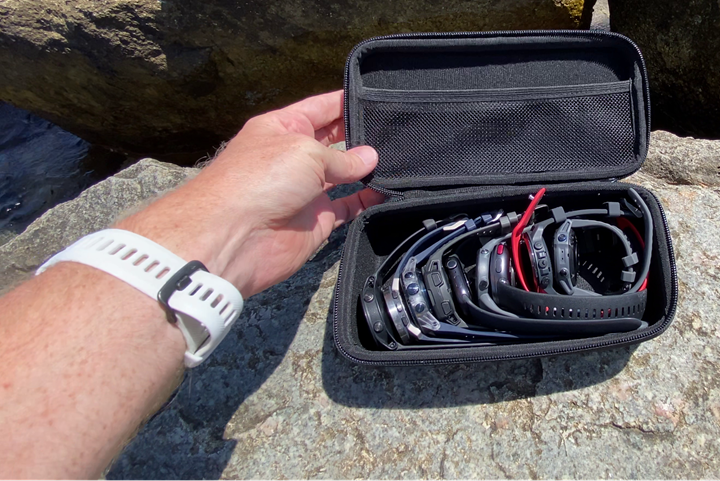
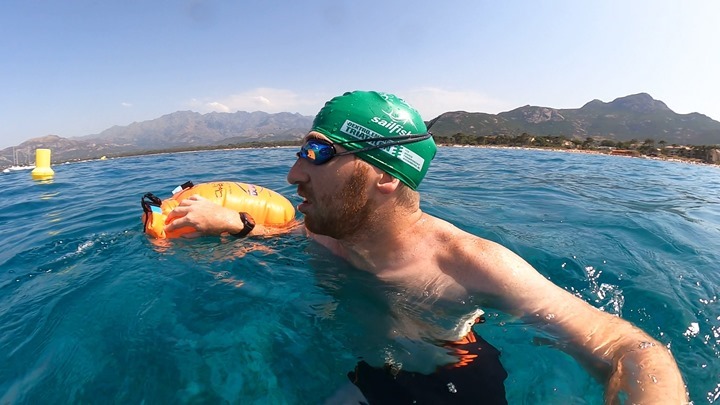
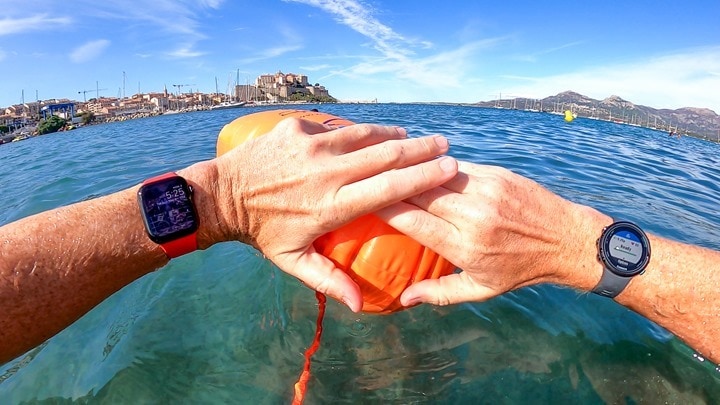

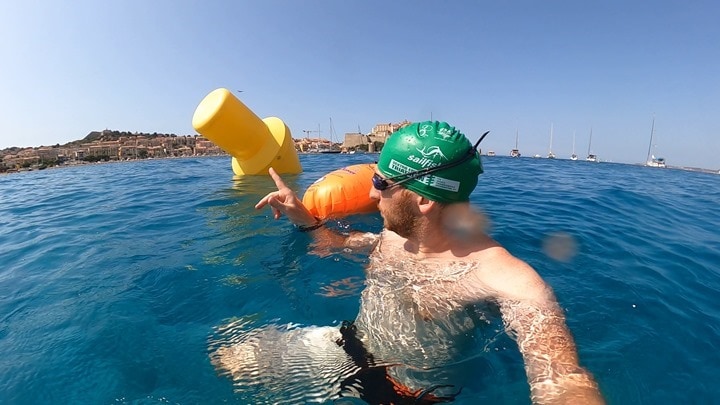
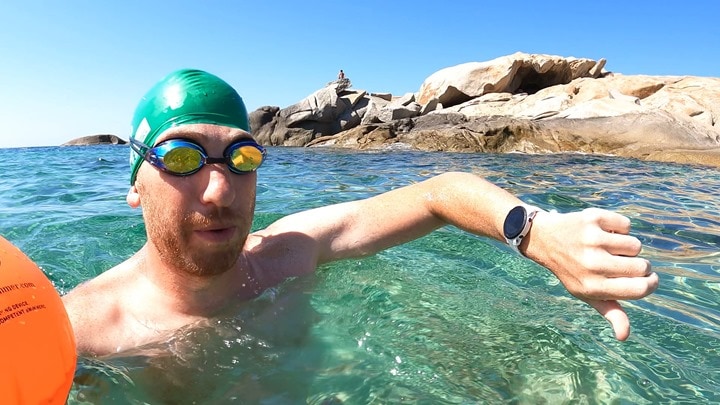





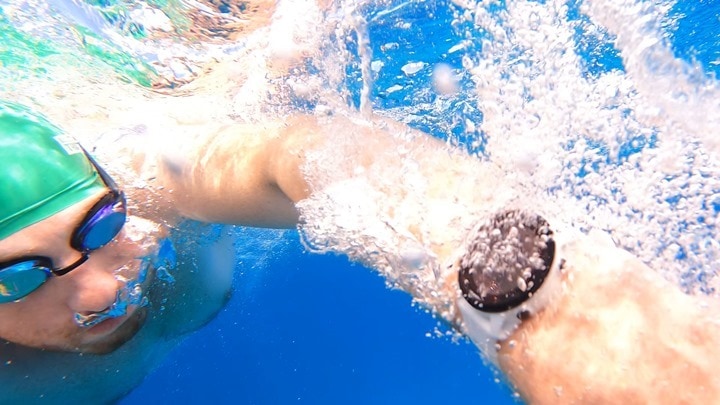




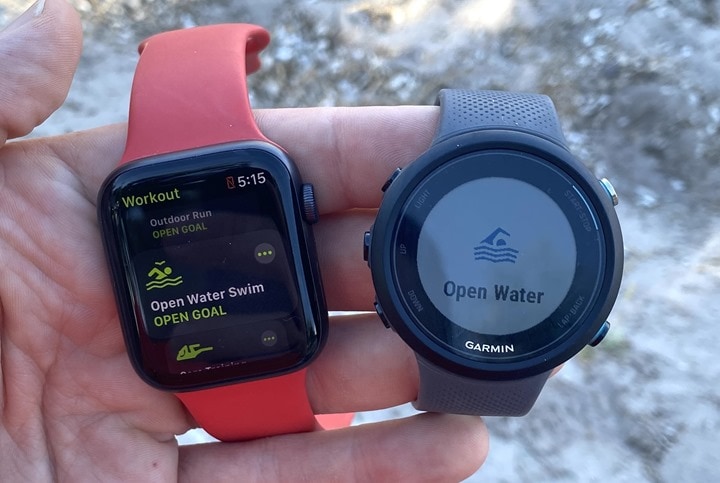



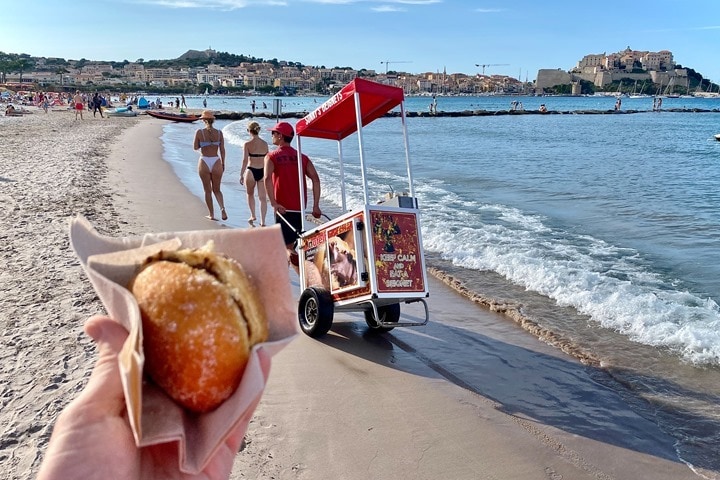
![clip_image001[6] clip_image001[6]](https://media.dcrainmaker.com/images/2021/08/clip_image0016_thumb-1.jpg)



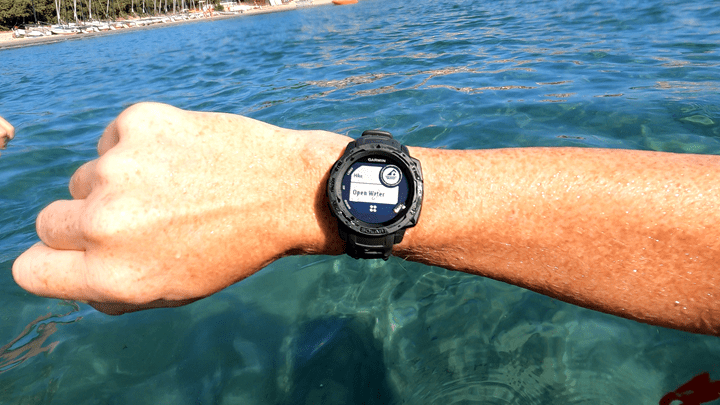




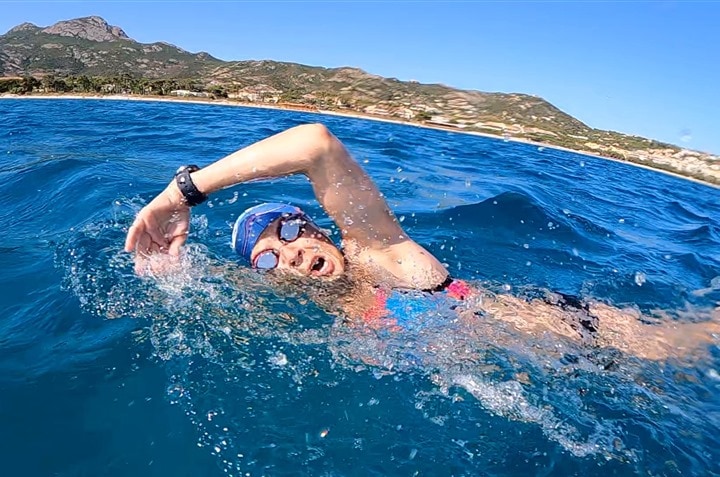
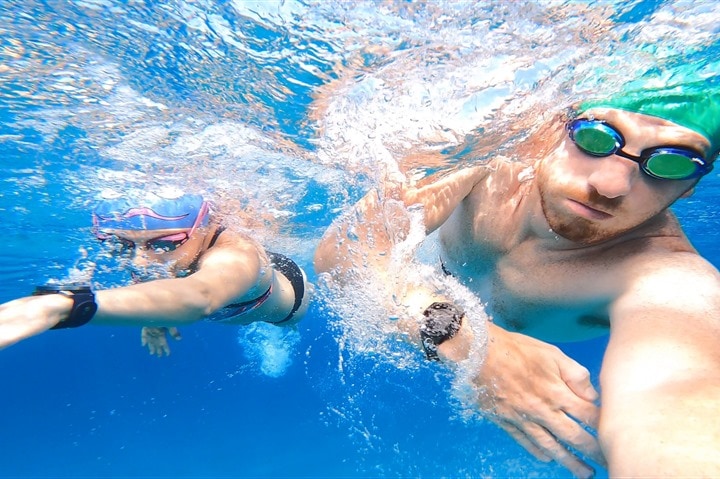



![clip_image001[10] clip_image001[10]](https://media.dcrainmaker.com/images/2021/08/clip_image00110_thumb.jpg)





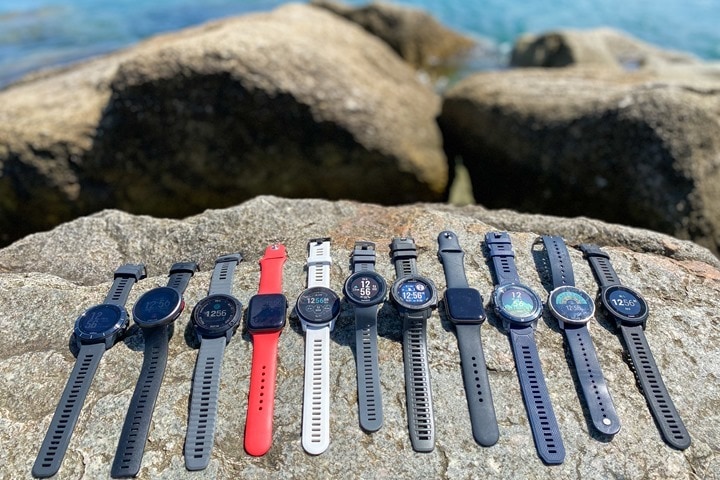
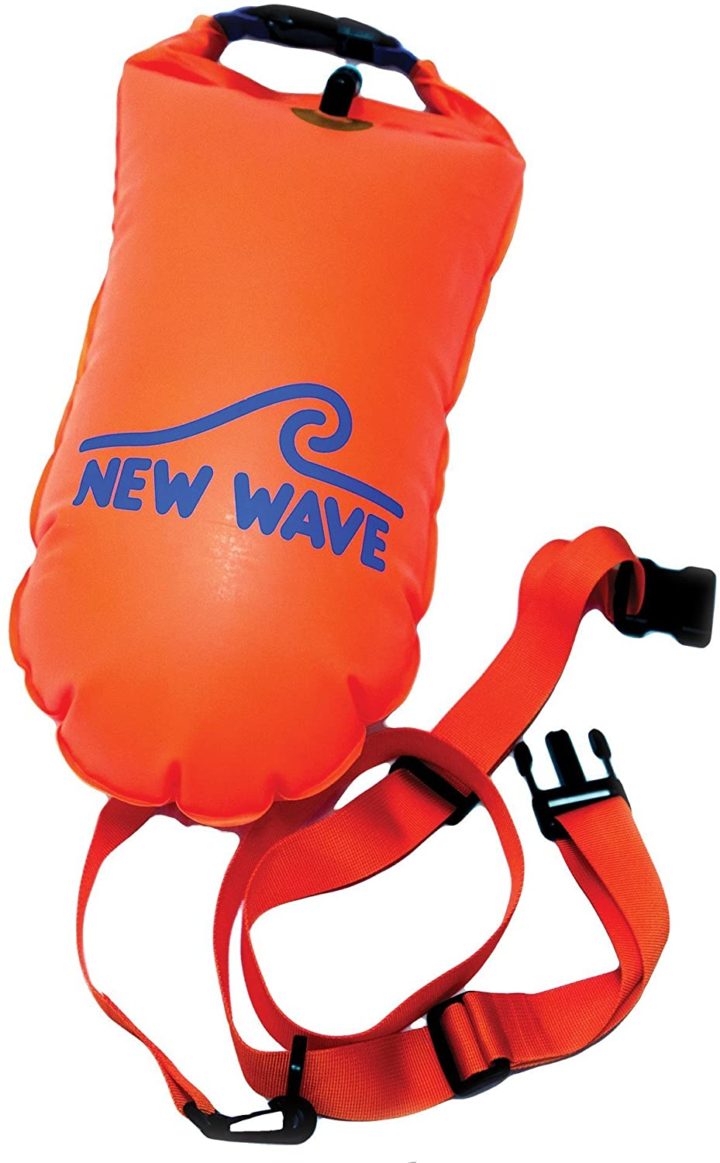
















Good to see your vacation end Ray, it’s been very quiet and hopefully this means some new posts are coming soon!
For your reference track have you considered something like a GPSMap 65? They produce considerably better tracks than the watches due to the better antenna, so even running in the woods you’d get a real reference track of where you were. Also, new toys are always nice so…
Also, don’t joke about Orcas, they’re angry right now since we no longer call them killer whales. They’ve started some beef with the yachting community in Biscay!
link to bbc.co.uk
The challenge is a bit of the weight. I probably could stick a GPSMap 65 inside the buoy, but in general, short of the rare scenario where the watch gets face-down in the water, my reference tracks usually come out exceptionally well.
But yup – lots of new posts lined up! This one took a weeeee bit longer than I thought it would, mainly the video edit, trying to consolidate so much footage from weeks of testing.
Regarding the Orcas, I literally just got served a YouTube algorithm video about them and sailors last night…
The algorithm is starting to see the future!! It’s the Internet telling you to start sailing more, I’d love to see you review some of the sailing tech I’ve been buying, the bugs are huge and obvious, and the kit makes a Fenix 9 look like a cheap Casio!
Yeah, I’d love to get into sailing. We had actually planned last summer to start sailing lessons (on little Hobie Cat-like boats) in the lake that’s directly in front of the DCR Cave. But, the world had other plans. Maybe next spring/summer.
The Netherlands has such ‘good’ weather for it, and for learning, given all the large inland water options that are still windy.
Until then, I’ll just keep watching SLV (and random Orca attack videos, apparently).
Sailing can be cheap or expensive. If you sail on someone else’s boat, cheap. If you open the boat, expensive.
If you have the time, I would recommend contacting the local yacht club and seeing if anyone is looking for crew for the local beer can race. Free, fun, opportunity to learn a lot, and there is a good chance the skipper will buy the first round when you pull in. Over time, you’ll learn not just how to sail a boat, but how to sail it well.
If you can attract sailing companies to send you gadgets to test on the water, you will be in very high demand regardless of skill once word gets around.
That is a great suggestion, as you say if Ray has the time with all his other work. I sailed with my wife’s cousin for a few years in the “beer races” as you put it. Good times.
Great post! Thanks Ray!
I’m experiencing really bad swim data on my Fenix 5x plus. You mentioned that Garmin put a lot of effort into the swim accuracy after your MARQ issues. Do you know if those issues were solved in F5Xplus? I guess not, since I’m not overly happy about its performance. If not fixed, I guess they wont fix it either for an old watch like mine?
The Fenix 5 Plus series actually did get a lot of fixes backported to it, as it had the GPS-track-stop issue too. In the case of the Fenix 5X Plus, the major swim-related fixes came in firmware version 8.01: link to www8.garmin.com
That’s a few years old now, so I’d assume your watch should be updated by now. The other thing that really does help, if you don’t already do it, is always press the start button with GPS locked, and above the water, and then really try and wait 10-15 seconds before diving it (and having the GPS go underwater). I’ve found across all brands that substantially helps.
I sold my Fenix 5s plus 2 months ago and bought the Fenix 6 pro and since then I see a clear improvement in the GPS tracks during open water swimming. The Fenix 5s plus created long lines in the canal where I normally swim, and it looks like I am drunk. The Fenix 6 pro has way more datapoints and creates a more fair straight line.
My 5 plus swim tracks did improve a while ago after being clearly broken by an update. No real issues with the 5 plus any more aside from true wireless buds with dual connections. Can’t wait for the next iteration though, the 6 pro has quite a few desirable features but I’ve waited too long so will wait just a little longer for the next version.
Ooh, maybe there’s hope for my 935 (Fenix-5-plastic) if it got those same software updates. I’ll try the 15 secs of wait after pressing start to see if that helps it get some accuracy. Currently I think it reports about 50% of my swim distance.
Well done! Serious work!
Do you know if those firmware updates will be available for 935? With 21.00 the open water accuracy is simply rubbish. It is quite annoying to see how something that worked perfectly is useless since 2 years ago.
I think most of 935 users feeling is like we have been abandoned just because the product has been discontinued.
Hmmm, it’s always fun to read these reviews. I’ve been swimming (a lot) in the ocean this summer with my Suunto 9 Peak. Compared with my buddies Garmins (945 and Fenix 6) it has been totally on track with the strava workouts as comparison. Though I agree that the watch in this test totally under performs.
Nice! I’d be curious how often, if ever, you stop (tread water with hands underwater) to wait a few seconds. That seems to be the common thread of failure for both myself, and my wife’s tracks, as well as my earlier Suunto 9 Peak failure back in June.
I’m in the middle of doing the Suunto 9 Peak tests and I’ve seen the same behavior.
Bad tracks and, if you stop for a while, GPS signal sinks.
I even had some days that the watch only tracked the first point on the beach and nothing after it.
Maybe it has something to do with the GPS settings and the applicable area? I’m mostly swimming in Norway and using GPS +QZSS + GALILIEO.
By the way, I regularly stop and have a chat with my buddies mid workout. It doesn’t seem to affect the track. In that case I pause the activity around 50% of the occasions.
Hi Ray, if i swim a loop around small islands and so I see that my garmin fenix 6 pro sapphire is spot on with the gps track but its about a couple of 100 meters short on a 3400m swim. Also in Xterra 1500 it says 1350 (which matches your findings) in an Ironman 3800m swim its always short. Is it possible that the gps track is great but the calculations to distance is not? Maybe garmin can fix that in a firmware update?
Gr
Awesome comparison, thanks for pulling it together.
Any word if Garmin is looking at the battery drain on the 945LTE when in OWS?
Your two tests show ~20-30% per hour (I know no the longest activities), but even at half of that estimated drain it seems like a full IM may be seriously risking running out? Based on this, maybe a way to turn off LTE during OWS for a live track / event share in hopes to save battery for a long bike/run.
Is there any way to turn it on/off mid activity (i.e. in T1?)
I’m guessing you had LTE enabled or it was contributing to the drain?
@Tim I second your questions, I have been thinking about LTE wearables and do I “need” them. I run with my phone but if I can leave it home and still message if I need help, that would be nice. Though then I am leaving may camera at horne to? hmm… lol
It would have been interesting to see how a watch that doesn’t support Open Water does for comparision. ie Garmin 245.
I have a Vivoactive 3. If you put it in a buoy it tracks great, though you have to change the activity afterwards. If you wear it and try it, it’s more jagged than that Polar. There are a few CIQ apps that try to enable GPS and track as open water swim – pretty bad as well still – but at least then it records as OWS so upload to Strava is correct.
Some interesting results here!
I’m surprised the Garmin Instinct showed some (relatively) good results, because for me it’s usually showing completely useless distances and tracks (instinct v1). Basically it loses GPS signal every time it’s submerged underwater and locks again only if I keep the watch out of the water for a while.
But every watch loses GPS when submerged. The watches with OWS modes have different algorithms and maybe sampling to try to make the track sensible.
Could anyone recommend a watch for swimming in front of a current generator like an endless pool? My instinct solar uses gps, and I am not doing any flip turns. Just swimming in one spot for thirty minutes. Is there anything that could estimate my yardage and track my heart rate?
It’s not possible to use a pool swim activity instead? That should turn off GPS and use accelerometers to guess-estimate the activity.
Those generally require you to identify the size of the pool you are in (25 yards, meters, 50 yards, meters…) and so they rely on you changing direction to obtain an estimate of your speed and yardage.
I think that you will have to determine water speed at the surface yourself with each speed setting of the endless pool (filming a floating duck toy or such?) And just multiply your swimming time with the water speed at that setting to get a distance. In the browser version of Garmin connect you can then create a new workout. No watch required :)
So funny that the good old Suunto Ambit3 Peak is much more accurate than the current Suuntos. It also has bad days but in general it’s pretty accurate in OWS.
Hey Ray! next time you’re in NL and are looking for someone to ride/swim with, hit me up!
link to instagram.com
Thanks Tony! Hopefully, conditions allow returns more frequently, back to our regular frequency (my wife is from St. John’s).
What you report with the fenix is interesting as I, and many other people see the same problems with running: track looks fine but distance is too short. My runs with the fenix are about 0:15-0:30 slower than reference due to this. Heck, even a sky diver reports this problem when jumping! There’s something setiously wrong with how garmin measures distance and calculates pace on the fenix 6 range.
Interesting, I definitely haven’t seen that. Just looking at a run from two weeks ago, compared to the FR945/Vertix1/Vertix2, it was basically a wash (and actually, the Fenix 6 was slightly longer).
Hi Ray,
did you switch the watches from left to right arm? I find that one of my arms will drag lower effectively spending less time above water.
I haven’t actually seen any difference in my swim stroke when switching arms. I did it as part of the FR745 LTE swims, and no changes there in terms of accuracy. Certainly, such differences might impact some people like you noted, but for me, it’s a wash.
The far bigger impact I’ve seen on accuracy is simply just stopping, and specifically, the recovery from that.
FR745 LTE – is it a typo? 😊
What a fantastic review! This is going to become the definitive open water swim watch article.
I’m already seeing it shared on swim groups and forums!
Thanks Grame – appreciate it!
Can you share which GPS settings your expect to work best on the various units? I have a Garmin 945 and my open water tracks are garbage and nothing like as clean as you’re getting here.
Appreciate the sacrifice in bringing your work on vacation Ray!
There are some intriguing outcomes here!
I was astonished by the Garmin Instinct’s (relatively) decent results, as it normally displays utterly meaningless distances and tracks for me (instinct v1). Basically, it loses GPS signal while immersed underwater and only locks back up if I take the watch out of the water for a long.
When swimming front crawl, the breathing side wrist typically spends more time above the water, which could affect your results. I see you marked the Suunto9Peak track with the wrist it was worn on but not the others. Can you please mark the tests with the wrist they were worn on (left/right) and also what your breathing pattern was?
I’ll add it into the set data, though, perhaps since I bilaterally breathe, I’ve never seen any difference in accuracy between sides (I know some people do, but not in my case).
Many thanks for the diligent testing and reporting.
I was hoping that a review like this would tell us which watches also display and record water temperature.
Interesting view of all the watches, I have recently bought a Garmin Swim 2
Which I find excellent, previously had a Suunto Ambit 3 sport which was a
nightmare, had problem with no GPS sent off it took 7 weeks to return, never
again buy a Suunto.. Happy with Garmin Swim 2. Woohoo.
Hi Ray,
thanks for the nice article, as always. One question: I also like to do open water swimming from time to time, however I prefer breaststroke. I guess this will not work with a watch on my wrist as it would be constantly under water, right? Did you ever try? (owning a Garmin Vivoactive 4 right now, I cannot test it. However I do use a swim buoy (inspired by you), so it is really not a big issue).
Greetings, Patrick
Patrick, I’m not sure anyone has replied, I just found this review, but breaststroke can be used with OWS, but you need to adjust a little and make sure hands, or watch hand at least, goes above water every stroke so when I did one of my few breaststroke open water swims I had to swim a but unordinary ;) It is a challenge!
Thanks Jens,
for the (only) reply. Thought so … Well maybe sometime I will own a capable device and then I will try. Before I used the buoy, I stopped from time to time and raised my hand for a while with the watch in normal GPS mode, but of course the results were horrible.
Greetings, Patrick
Hi Ray.
Any news about Swim RR, recorded when using HRM-Pro with FR945 and plus?
HRM-Pro v7.40 records Swim R-R, not yet announced.
Only FitFileRepairTool deals with it.
Hi Ray just a quick question: I own an Instict (not-solar) and it tracks pretty well (no weird lines) but while swimming when I take a break and before I pause the activity, it still increases the distance, something that may last for minutes(I guess it ‘connects the dots’). So if I stop it then I may have inaccurate distance, but if I don’t then I have inaccurate time and pace…
Does this happen with other watches too? What would you suggest me (pause or let it count?)
HI DC Rainmaker, do any of the watches measure water temperature? I like cold water swimming and that measurement is just as important as the swimming accuracy, since I am probably swimming in circles hoping to stay warm!
The Fenix 6 definitely measures temperature for open water swimming. I’m guessing all Garmin with a temperature sensor will.
No longer possible to get the DCR swim bouy? I still have mine from however long ago…
Nice! It’s a keeper!
But no, no longer possible for the DCR branded one. It was something I did with Clever Training years ago, primarily when swim buoys were a rare thing. These days, thankfully they’re far more widely available. :)
Totally agree on this front. Buoys back when your ISHOF DCR Branded one came out were almost unheard of around the lakes here. Now in 2021 it seems very common, and I think that’s great.
Yup, I’m amazed how often I see them. In Amsterdam at the lake I swim at, the vast majority of people doing ‘legit’ openwater swims (going say more than 100m from the swim dock) have them. That’s awesome!
F6X seems have improved with latest beta. Tracks look good in most cases now.
I still have the following cases:
– track is to short, up to 20%
– distance is almost correct. But ends in the middle of the sea. Recorded GPS Track is 25% too short.
What would be interesting in your Tests would be to see the recorded GPS points.
I use viewer from link to fitfileviewer.com to extract the recordings in CSV format.
This works fine for Garmin devices. Then you can see when GPS data are available. And when the watch tries to
apply some algorithm. I would be interested how much GPS points you get compared to me. I could do this for you.
As i noticed with your tests, Garmin tends to understimate distance as i tested here: link to youtube.com .
Great you got time away – although I suspect some time might also have been spent testing [emargoed], [emargoed], [emargoed], [embargoed] etc etc etc ahead of what seems to be an epic Wahoo, Shimano etc Eurobike next week!
I don’t open water swim, which may be why I don’t know the answer to this question. If swimming heart rate is inaccurate at best, and underwater GPS is nonsense, why not use the swim buoy method for all measurement, i.e. for “normal people” swimming everyday? I understand in a race scenario where organizers don’t allow buoys or a triathlon not wanting to spend time getting the watch off the buoy and onto the wrist, but in those case the course is measured and laid out already so exact distance isn’t essential.
This makes so much sense that it’s crazy talk surely!
P.S. i don’t do OWS either :P
For me there would be two reasons:
– If you attach your watch go the swim buoy, there is no way to see your metrics mid-swim.
– Many people, including me, do not use a swim buoy, as they swim in a place that has no boats and that has safety cover (e.g., I swim in the docks in Liverpool).
Noting the increased distance over the reference track appears to happen consistently with all the watches that operated through the whole test. Is it possible that the extra distance came from the arm swings into the air above water, much like we account for accents and descents in cycling distances?
It’s a bit of a “late to the party” sort of thing since the company is about to go bust, but I highly recommend the Platysens Marlin swim tracker. The gps unit sits on the back of your head so avoids the loss of contact issue with watches and thanks to is bone conductor speaker gives you audio feed back on pace, time, distance and even live HR data if you add a polar OH1 to the set up. It’s a real shame since it is a unique gadget and the audio feed back is awesome, particularly the HR.
Hi. Thanks for a well researched and written review .
I have a 935 and find that whilst straight line swims are reasonably accurate, that it simply can’t cope with a 310m triangle course. It is off by as much as 20%. This is consistent for 3 years and with 2 separate units with all settings tried.
I would love to see you test the watches on a triangle sometime. That would be the acid test!
Finally, are you using GPS and Gallileo on the Garmins?
Thanks Guy Molyneux.
you could put a gps receiver, 5g-wifi ap,satphone,donut stash on the swim buoy
DC, have you thought about using Fenix 5x in the water tracking function? But news for Garmin’s sales department, I have my calories in water, but I have to edit the GPS. Goal. PS. Ultra track GPS funcion.
Is there some kind of GPS-puck that you can connect to your watch for open water swimming? That way you could get all the swim-statistics on/from your wrist, but use GPS-data from the external GPS that you have either in your swim buoy or under the swim-cap. Something that can store the GPS-data and then merge with your workout, the same that you sync HR-data from your chest strap via bluetooth after you get out of the water.
Considering that 945 LTE has LTE, I wonder if it can do A-GPS to get a lock faster / stay locked longer? I assume it would be easier to get A-GPS fix via LTE than wait for satellite signals…
How about Edge 520 ? :D
Some time ago I’ve seen it on some ironman run gear statistics
w
Where do you think the cheapie Garmin 45 fits in? Are the insides the same as the insight?
One other thought. I do laps. Back and forth across a lake. I wonder if the stopping and turning around messes with things.
Thanks so much
I’ve got one important question regarding the Apple Watch & iPhone. If I swim with both (AW on the wrist and iPhone in a buoy dry-pocket) is there a way to force the AW to use the GPS from iPhone? When I’m swimming open water with breaststroke I get almost no tracking of the distance (because the watch is under water). But when swimming with iPhone anyways – can’t it take the GPS data from the watch? I’ve tested it – and it doesn’t :/ Or maybe there are some external GPS devices which could be connected to AW/ iPhone? I know you can put your AW inside of your swimming cap – but then – you loose the HR data.
Hi,
My 935 performs terribly during open water swims. I give it enough time to acquire a GPS signal and I raise my hand during breaks. Still terrible measurements. I’m swimming on land and the lines are way too straight. Software version 21.00, GPS version 2.70, auto-update on. Is there something I can do?
For really accurate swim tracking you need something that is out of the water – as soon as the watch dips below the surface it loses GPS signal. You can opt for a faster refresh rate on your watch – but that is only partially effective, also worth setting your watch to GPS+GLONASS or GPS+Galileo to improve the range of satellites you can access. Putting your watch in your swim cap works but you lose some of the swim metrics, like stroke rate. A better option is the Marlin Platysens swim tracker. The software could really do with an update to smooth out the track and improve the accuracy, but it’s a great gadget and gives you real time swimming information via it’s bone conductor speaker. Paired with a polar HR device it will even give you live HR data.
Hi Christian,
Thanks for helping me! I put it on GPS+Galileo for OWS. Also, I changed System >> Data Recording from “Smart” to “Every Second”. Will test tomorrow! If that doesn’t work I’ll try putting it under my swim cap. Thanks again!
Hi Albert-Jan,
First of all: You are doing crawl right? If it’s breast stroke, then OWS is very hard for a watch since the watch is so long under the water. If you are doing breast stroke, you are “out of luck” I would say. However if it’s crawl, then changing to 1s recording should improve things. I read people who complain about their OWS with various watches but IMO it really is all about technique. I’ve been doing OWS with Fenix 3, 735XT, 935, Fenix 5S, Fenix 5X Plus, Fenix 6X Pro Solar as well as several Polar and Suunto models and none of them have failed, except for the one time I tried breast stroke and did not make sure I put the hands above water frequently. As long as you don’t stop while swimming it should be fine. If you DO stop you need to hold the hand with the watch above water.
BTW I use GPS + Glonass but Galileo should work well too I’d expect.
Good luck and please update with your results!
Hi Jens,
Thanks for your comment! Yes I’m doing crawl. I’ve done quite a bit of experimenting today. I did 4 short swims:
-I added Galileo or Glonass to GPS (both help equally well).
-I also switched between left/right wrist, but that didn’t help.
I now use 1s recordings. Half way somebody remarked that a reset of the watch might help. So I turned my watch off and on (it had been on for multiple years!).
All in all, the signal has improved a LOT, though the lines still look unrealistically straight. A tiny benchmark in Running Mode with my hand above the water showed a similar distance. Today was quite windy, with pretty big waves, which probably doesn’t help either.
I don’t know if there are any downsides (eg less battery life, too much data) to tge changed defaults.
Best wishes,
Albert-Jan
Great review thanks. The assessment of Suunto especially agrees with my experience where I had a Suunto spartan a few years ago that was extremely inaccurate in open water. Full of random tracks perpendicular to the swim direction and wildly different to tracking of swim companions watches (Garmin) I complained to Suunto – they attempted to fix the problems and failed. Infuriatingly Suunto explained that the problem was that because I was swimming the watch was losing contact with satellites when my arm goes underwater. Why have an open water feature if that’s going to be a problem I ask??? Eventually the retailer agreed to replace my watch. Still didn’t fix the problem of course because as you have explained it comes down to the magic in the algorithm…Apple watches have been much more accurate for open water in my experience.
What’s missing is a comparison graph at the end. Price, open water accuracy, lap counting, workout programs, smart watch features ect. Knowing open water accuracy is real nice to see. Though making comparisons what else the watches do is what allot of us do when buying a watch. Like maybe putting a watch in the swim cap might make sense if finding one’s phone is more important. Besides some of us want quick information.
Any chance of a new openwater Extravaganza – especially as there are so many new models running mult-band gps – would think it would be interesting to see who is the best in the water – and whether mulit-band is making a marked difference with open water.
And please swim a 300m triangular course. That’s the challenge. Straight line courses are easy for the watches. They fail spectacularly on triangles.
Triangular courses are actually the easiest for watches, because the change in compass heading is easy for most watches to pick-up (at least, most watches made in the last few years). The act of a turn, assuming no underwear sections (e.g. crowding at a buoy), is the easy trigger point for most watches.
Turns in any course can be a challenge, but a straight triangle tends to be pretty easy, and you can see that in my triangle course above.
The most challenging courses tend to be ones with more subtle turns.
That said, with multiband, I’m seeing really good performance on watches in openwater swims across the board these days. It’s substantially helped. It’s very rare for me to have big failures, or even minor failures. I’ve got some warmer locales over the next few weeks, so I might make a go of an extravaganza again.
Thanks for your reply. I disagree however. Based on hundreds of open water swims, the Garmin 935 and Swim 2 always truncate the apices of triangles. Much more accurate in straight lines. The 935 records about 10% of the data points compared to a BTG31 ( both in a swim hat for that test). I even sent the 935 back and received a replacement.
Yeah, the Garmin FR935 is more than 7 years old now. A lot’s changed in GPS chipsets and how things handle. Cheers!
Ray,
I also loved the extravaganza, and i’m also in for a new one!
Currently i’m looking for a watch, without much demands, but i do have:
– OWS GPS accuracy (I’m a tile-hunter, also in the water ;) )
– Dense forrest GPS accuracy (mountainbike tile hunting ;) )
– Not Garmin (A person can handle only so much software failures in ones lifetime, I started with the 705 bikecomputer and had my share of next Garmin devices, now finaly going to the new Karoo 3)
– On the lower hand of the pricescale, max 200 dollar/euro pricepoint
I’m reading all your stuff, great! and can do my own in depth reading of your tests.
But could you (or maybe also other users here) name me 3 devices that come into your mind considering above demands? Al then dive into your reviews of those.
That’s tough, because practically speaking, the best accuracy in the most demanding environments is Garmin these days. There’s no two ways about it.
Behind them, I’d put Suunto as a close-2nd when it comes to GPS accuracy (but very far behind when it comes to optical HR sensor accuracy). But that’s for the Suunto Race/Vertical, which are all priced rather high compared to the $200 price point.
The closest you’ve got in that $200 price point that’s a good balance is the COROS Pace 3. Else unfortunately, nothing else is coming close on your price requirement that’s not Garmin. For Garmin, the Forerunner 255 would be the closest, and one of the most accurate watches out there.
Thx Ray, I Did find the Pace 3 Already, after your reviews, and was on 1 on my shortlist.
Will dive into the Suunto.
thanks
I am looking for a mid priced smartwatch for open water. Any updated suggestion? Thanks a lot for your effort!
hi, what smartwacth do you recommend that can answer the phone, wallet, battery 4-5 days and barks a decent gps and metrics. I have Huawei watch3 pro, but the metrics are ridiculous, it doesn’t have time to pause in swimming and mountain biking, not even repeatedly when talking and finally the GPS loses the signal too often, even if the distances strangely correspond to the other devices.
I also bought a Samsung watch 4 but in the pool the laps don’t count if you change your style!!!! and even here the GPS was miserable. I was thinking about the Fenix or Epix doing mtb enduro, but I would have to give up the phone calls. Thanks in advance
Great in depth article,
Thank you for taking the time to write.
I was wondering the best set up in 2024 and if you would be able to advise? Not so much on the watch front, but with the external gps tracking unit/options to go into the Swim Bouy.
I use Apple Watch, and would love to get my distances etc correct through another device added and synced.
Thanks for the article, and hope it’s too much asking the above.
All the best 😊
Hey Ray, I found this article during searching for reasons for wrong open water distances using the coros pace 3 since July 2024. My usual distance in a small lake near to my house is about 1000 m in one round close to the edge (10 to 15 m).The synchronization with komoot showed a difference up to 200 m more on the coros watch, sometimes more.I had no Idea and asked for help at the coros support. And I looked for forums.
After eliminating nearly everything like tighten the watch stronger, resetting, setting GPS to dual mode, looking for correct swimstyle ( freestyle)and so on, I made some tests:
Fixing the watch on my buoy, changing the wrist, swimming with my husband besides me (he uses the same model and had no problems), me swimming with both watches on both wrists, on wrist and buoy…
The very funny result: we have a floating line in that lake, which separates swimmers from non swimmers. And after a lot of tests I suggested a mistake in measuring GPS when diving under the line and pulling my buoy through, which takes 3 or 4 seconds as I have to turn around and bring the line over the buoy . It is reproducible. Starting the GPS mode after this line ( and finishing vice versa) gets right data!!!
If a swim without the buoy and swim quickly through, there is no addition in distance. With buoy and diving under this line the distance is too high. I do not know why and coros gave me no answer. It seems to me as if there is a struggle in GPS, or some “artefacts”. I write this to you with my bad English, because I think, it could be interesting for other swimmers.
Best regards
Christine from the North of Germany
P S. Every other distances in pools, during biking or hiking seemed all the time to be correct.